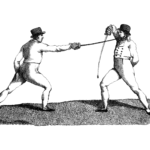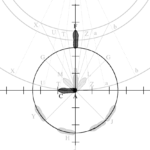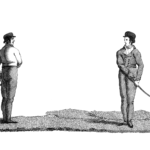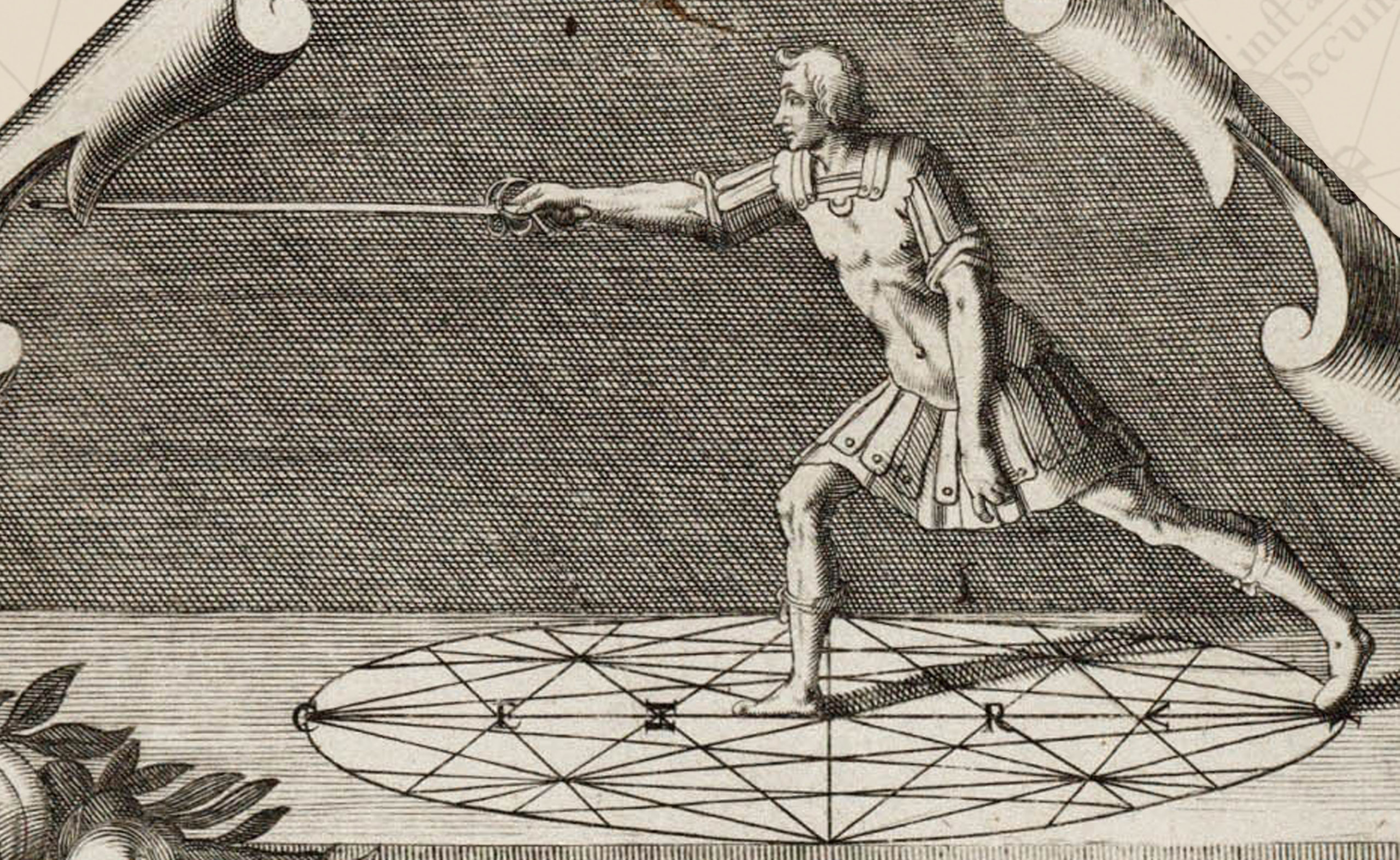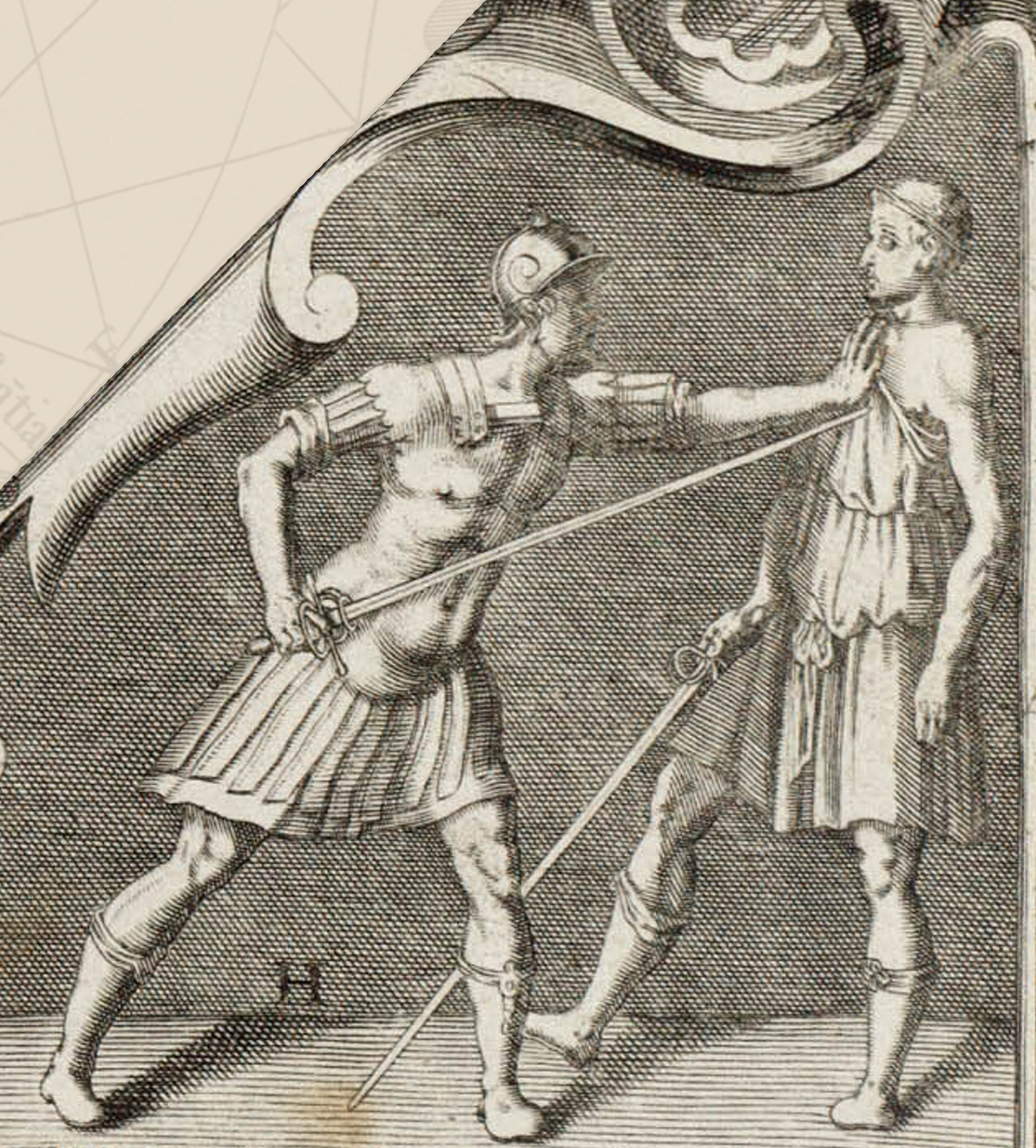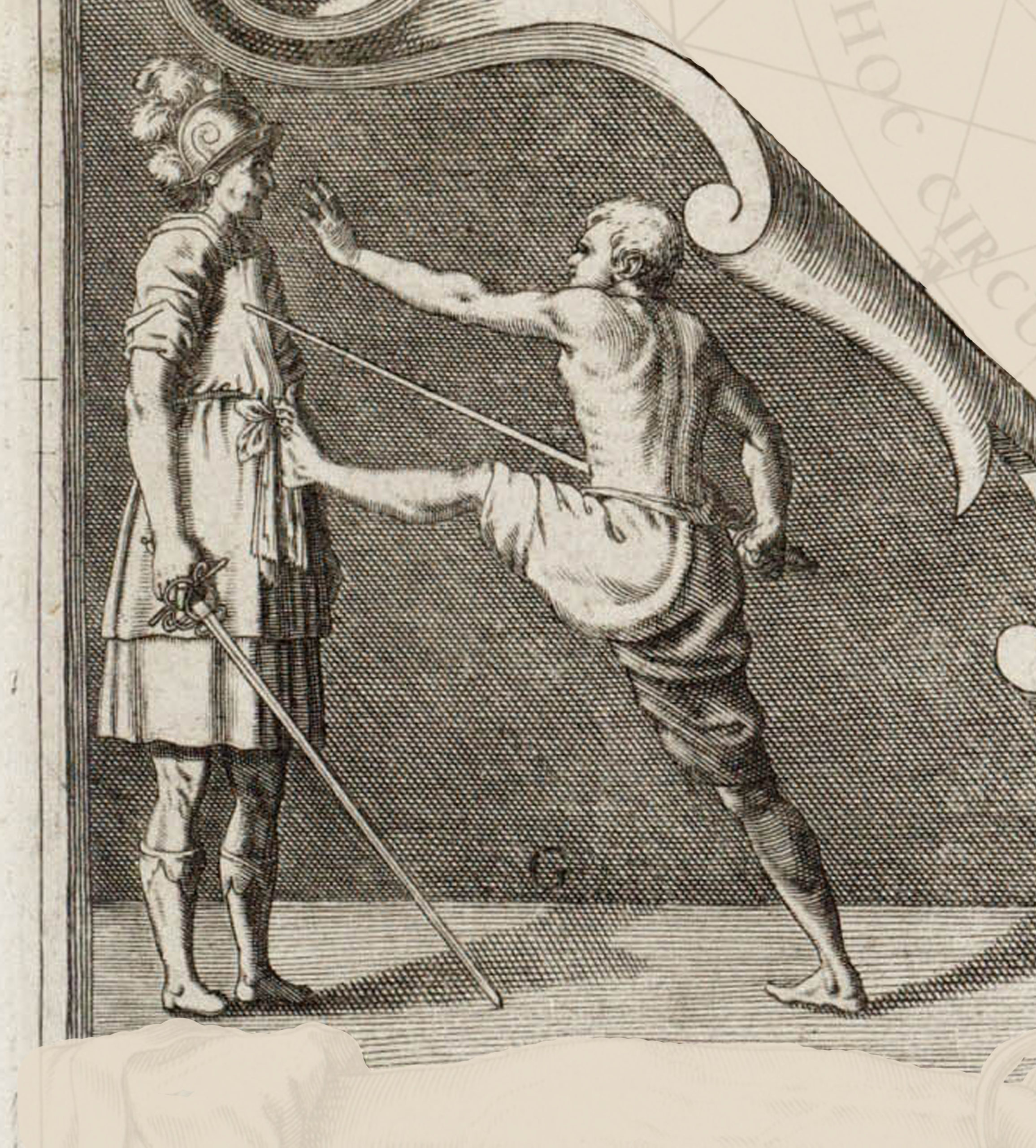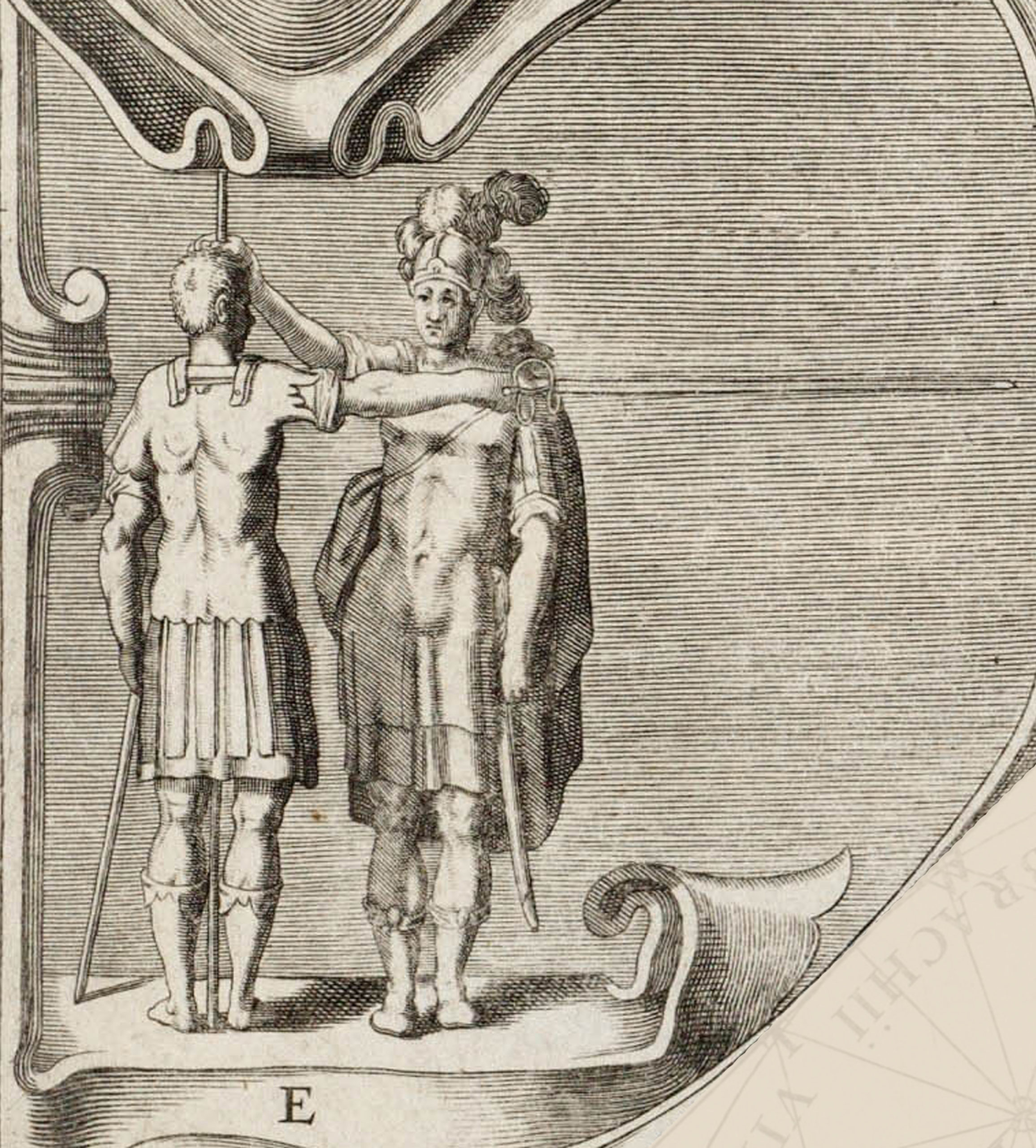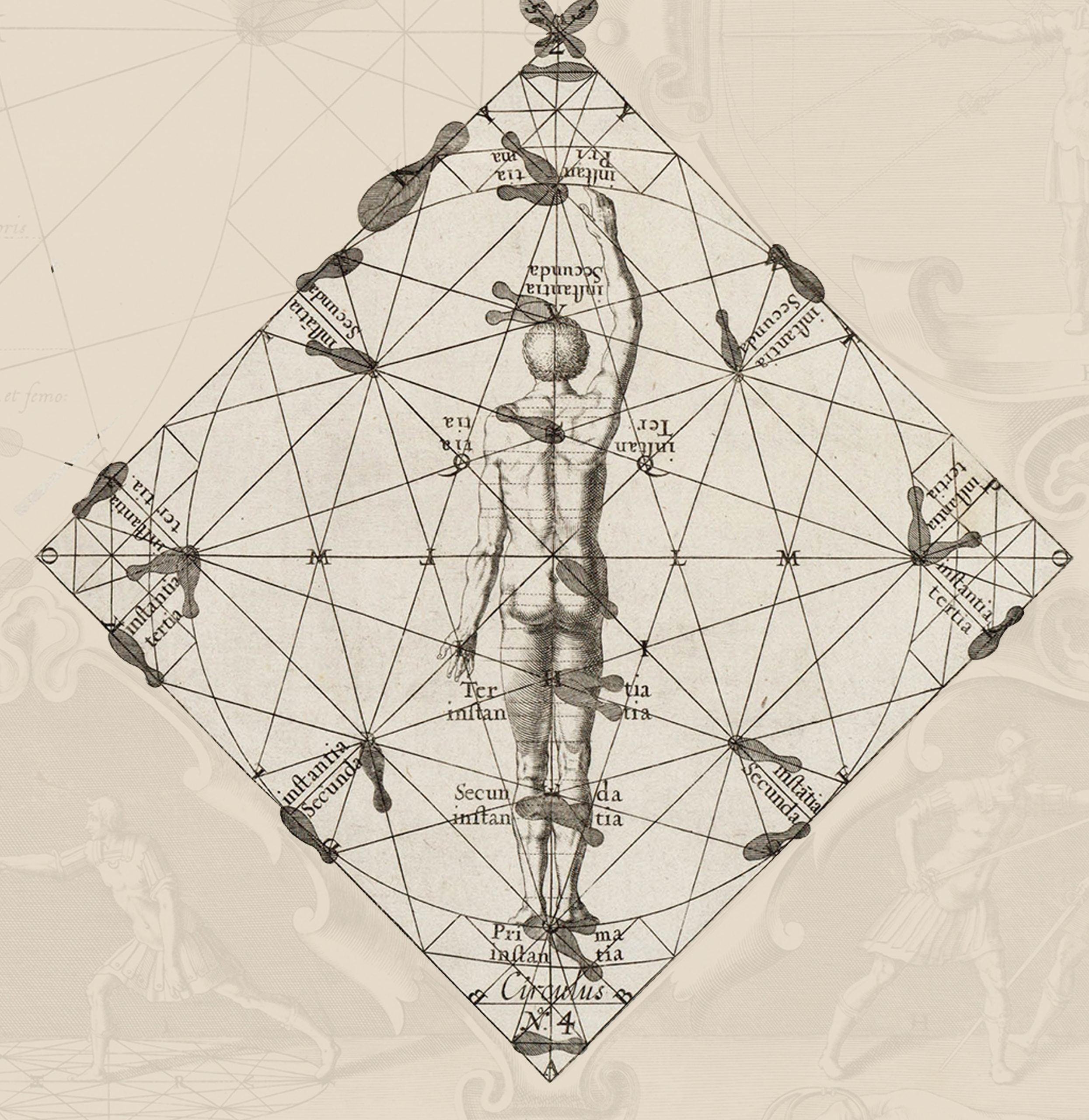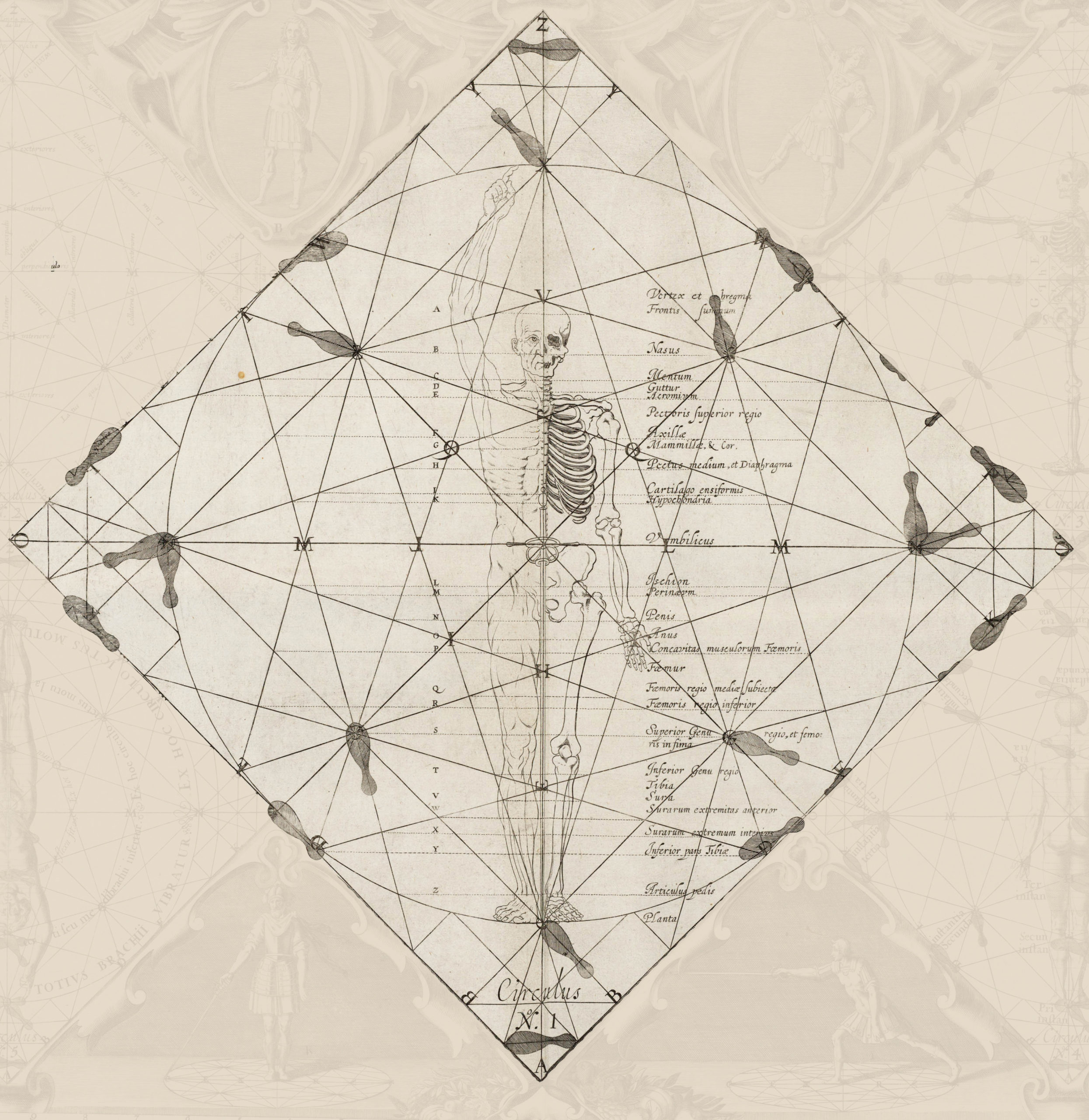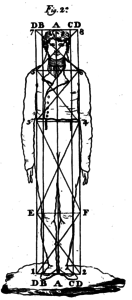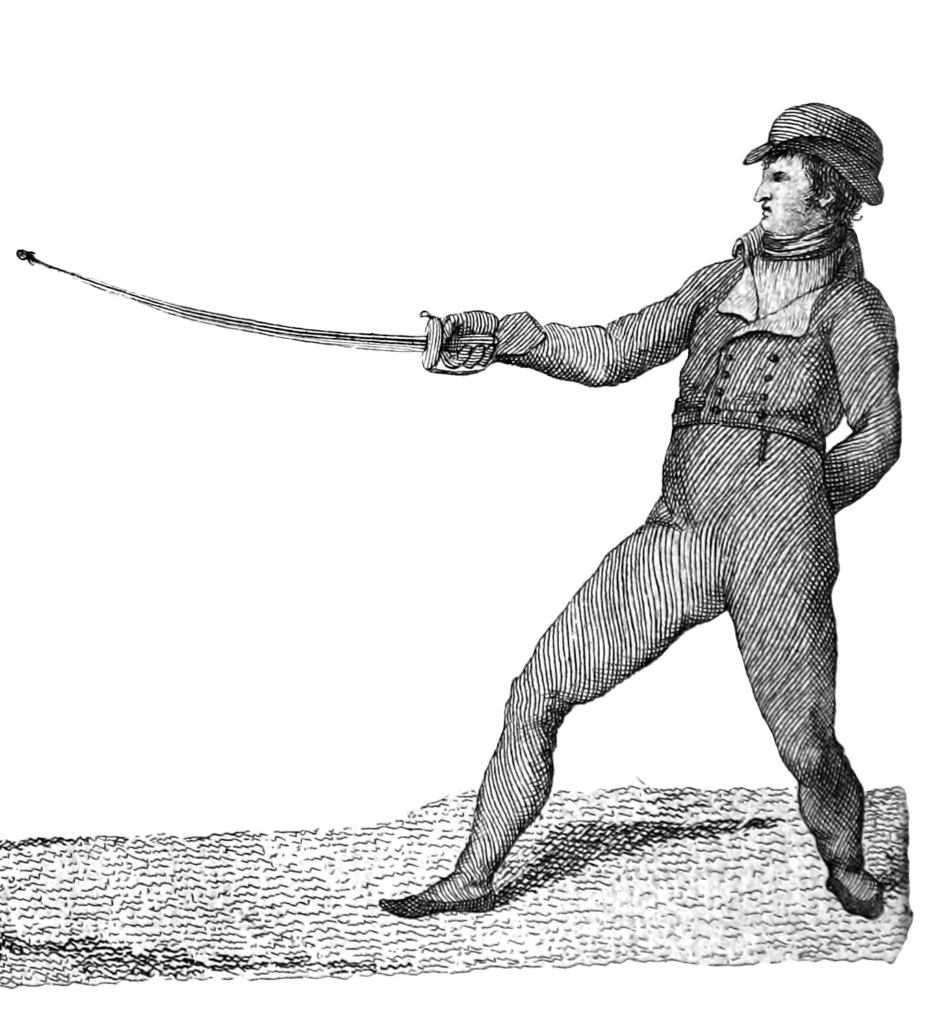Graduation and Transfer of Guards
103. In the previous chapter, I have treated on the way of asserting the guards. But, since the enemy is free to do the same, asserting himself in some of these, we would see ourselves needing to obey his designs, even if it was harmful to us if you have no discretion to circumvent their intention by means of useful operations. This would be a fault that would obscure the merits of the skill. To avoid this defect, I will give the necessary rules to make his attempts ineffective in such circumstances.
Transferring the Guard of Fourth
104. To transfer the guards, it is necessary to be informed as to the significance of the words graduate* and transfer. Graduating is nothing but mastering the weak of the contrary sabre with the strong of your own. This is not limited to cases of finding one’s own strong on the weak of the contrary, but also where it has been dominated by the enemy’s sabre. Even finding yourself underneath, whatever action is exercised by the other will bear little fruit. By virtue of this, they cannot depart from the place or planes they occupy, and this can be easily facilitated by walking where it is agreeable to dominate, above or below him. This operation always precedes the graduation, so it is called the method of transferring. I will explain.
* He who graduates his sabre degrades the contrary, and therefore we call the graduated the agent and the degraded the patient.
Frias’ use of Transfering (transferir) is similar to the concept of Transferido or stealing what the opponent wants. Where Transferido is more typically applied to attacks, Frias applies it here to guards. So, in paragraphs 105-108, the basic setup is that fighter A takes a guard, and fighter B responds by graduating and transferring from a position where they are dominated by that guard to a position where they are dominating the opponent with that same guard.
105. If the contrary has taken the guard of fourth to take away the point of the other sabre, the one who is still in the common guard may transfer in the same fourth by graduating fully in the following way. From the common guard, turn the hand to half-fourth, and keep your arm in the arrangement and planes of the guard. Raise the point of the sword with only your wrist, making it run on the edge of the contrary until the strong of your own has dominion over the weak of the other, which will be when you touch the part where the counter-edge is born, more or less. From this position, the point will describe a diagonal line that passes between the two bodies, from the left side of the enemy to the right, accompanied by the necessary movement of arm and hand to make a good removal of fourth, taking with it the contrary point outside of the left vertical. With this will be transferred the guard that the opponent had taken with the help of irresistible graduation. Note that these movements will end with a rearward step, which must change from the offensive. Do this with all of the transfers which comprise this chapter.
Fighter A assumes the guard of fourth. Fighter B graduates the engagement and steals the guard of fourth.
Transferring the Guard of Third
106. If, gaining the time, the enemy asserts himself in the guard of third, that they wanted to take, having in it a well founded hope of advantageous assault, transfer it by virtue of the following operation. He who takes the guard or removal of third does so taking the point of the contrary sabre out of the right vertical, since this arrangement is dominant. Lifting your point by an action of the wrist alone, turn your hand to the position of half third, run your own sabre along the edge of the opposite past the middle of his weak, with which you will be dominant, or likewise, so that the strong of the one who was in the common guard is superior in degree to the one who previously attacked. The superiority, or graduation, will allow you to pass with the necessary movements of the arm, hand, and weapon, to the true removal of third. With this, carry the point of the contrary out of the right vertical and, in this way, you have completed the indicated transfer.
Fighter A assumes the guard of third. Fighter B graduates the engagement and steals the guard of third.
Transferring the Guard of Sixth
107. To transfer this guard, it is necessary that, from the common (in which the contrary has left the combatant in anticipation of forming that of sixth) fully graduate your sword, going downward with the point, with only the wrist, by the edge of the opposite, until it is on the weak of the other. Turn your hand into third position, raising it at the same time to the supreme plane and passing your point below the opposite guard to its right side, take the sabres to the sixth removal without separating a moment from the contrary, and dominate his weak. In the absence of this circumstance, no transfer is without danger.
Fighter A assumes the guard of sixth. Fighter B graduates the engagement and steals the guard of sixth.
Transferring the Guard of Fifth
108. This guard is transferred, provided that the opposite is affirmed in it, it is judged that this operation provides some advantage. To achieve it from the common guard, in which the combatant is found, and by virtue of which the weak of your own sabre is on the strong of your enemy, turn your hand to fourth position and graduate your sabre with your wrist alone, making it run over the other, to put your strong on top of their weak, taking the point out from your own left vertical and, from here, turn your hand fully into third position, circling your sword to pass the point below the other sabre and, without disengaging, place it outside the left vertical of your opposite, to the height of the median plane, while, at the same time, raising the guard to the supreme plane, covering with it the right vertical, forming the parry of fifth, containing the point of the contrary sabre outside of the same vertical, having the intended outcome.
Fighter A assumes the guard of fifth. Fighter B graduates the engagement and steals the guard of fifth.
Opposition to the Guards
109. Among the most important matters of the skill is how to oppose the guards because, most times, this single operation will throw to the ground the best ideas of the enemy. Because, if this has taken someone while in the offensive stance, it is surely their plan to attack to a point that has been uncovered by virtue of their enemy’s guard, and with confidence that the blow is always carried out with speed and opposition certain of its effect, which diligence will never omit to provide. But all of his work will be useless if you oppose it with another, changing the position, varying also the disposition that he seeks. If your enemy transfers the guard in which you waited for him, they will uncover by this means the points where you can direct the offense. So, if their guard does not immediately oppose, remove to their guard, it will be very difficult to free. Many other important advantages are born of the operation of opposing one removal to another but, in the gift of brevity, I will omit to recount them and will only teach you the exercises for battles, as I will explain forthwith.
Opposition of guards occurs when fighter A assumes a guard and fighter B yields their point to the movement and then raises or lowers their hand to take a guard between fighter A’s blade and the diameter.
Opposition to the Guard of Fourth
110. Opposing the removal is an operation by which you limit the enemy to only a single point of attack or, if they are determined to wait, forming a battle plan entirely different from the one they had premeditated. Assume the guard of fourth, either by choice, or because of a transfer. You must oppose or remove it in this manner in order to try to force him to attack or to undertake a battle very different from what he intended. When the enemy begins to move to take or transfer the guard of fourth, turn your hand fully to third position, raise, removing the point outside of the contrary’s left vertical, and do everything said above in order to form the guard of fifth, taking care that this operation and the defensive step must finish at the same moment, and you will have done the opposition of the guard of fourth with that of fifth.
Fighter A assumes the guard of fourth, pushing the blades in a movement of remission to Fighter B’s outside line. In response, Fighter B, yields the point and raises their hand to form the guard of fifth.
Opposition to the Guard of Third
111. If the contrary transferred or took the guard of third to oblige you to attack or to attack on it, turn the hand fully to third position from the common guard without disengaging the weapons. Feigning ignorance of the arrangement of the enemy, make a perfect sixth removal, taking at the same time the defensive stance, and the opposition will have been made to the third guard.
Fighter A assumes the guard of third, pushing the blades in a movement of remission to Fighter B’s inside line. In response, Fighter B, yields the point and raises their hand to form the guard of sixth.
Opposition to the Guard of Sixth
112. To oppose the sixth guard, having been taken or transferred by the contrary, turn the hand to the half third position from the common guard, or sixth if it is there, and come to a perfect removal of third under the circumstances and for the ends as before.
Fighter A assumes the guard of sixth, pushing the blades in a movement of remission to Fighter B’s outside line. In response, Fighter B, yields the point and lowers their hand to form the guard of third.
Opposition to the Guard of Fifth
113. To oppose this guard, turn your hand from the common guard to the half fourth position and make a perfect removal of the same name. You will have opposed the guard of fifth.
Fighter A assumes the guard of fifth, pushing the blades in a movement of remission to Fighter B’s outside line. In response, Fighter B, yields the point and lowers their hand to form the guard of fourth.
Carrying of One Removal to Another
114. Carrying from one removal to another is an operation by virtue of which you pass your own sabre, taking the contrary from one vertical to another. This serves not only to alter the intention of the opponent when they resolve to wait in the common guard with the design of achieving some response, but when he tries to rush to a determined point form the same guard, judging himself superior in that operation to his enemy. And also, as I have said, since it makes it easier for the one who carries, to uncover points to achieve some premeditated shot, it is one of the most useful operations of the skill.
Carrying is the same as a classical transport where all of the motive power is coming from the person executing it, rather than as a yielding action like in opposition. This creates a diagonal change of line where the engagement moves from high-inside to low outside, or vice versa, or from high-outside to low inside, or vice versa. This can be done as the beginning of an offensive action, or as a parrying action.
Carrying the Removal of Fourth to That of Fifth
115. To make this operation it is necessary to be affirmed in the guard of fourth, containing with it the other sabre outside of the left vertical, basing your point to the right of the enemy, and making your own sword circle, raise the hand to the height of the supreme plane, moving so that, when it arrives at this plane, it is already fully in third position, making a semicircle with the point of the sabre in front of the enemy to the height of the middle plane, or lower, until you finish outside of his left vertical, taking the contrary weapon with your strong. With that you will have achieved your intention and taken the fourth removal to fifth.
Fighter A holds Fighter B’s sword in the guard of fourth. Fighter A carries the engagement to the guard of fifth.
Carrying the Removal of Third to That of Sixth
116. The operation of carrying from the third removal to that of the sixth begins by turning the hand fully into third position. Lower the point to the height of the median plane and raise the guard to the supreme plane without leaving the right vertical which it is in, and all of this within one time so that, without disengaging the sabres, you will start to form the sixth removal. Carry the contrary sword outside of your left vertical constraining it with your strong.
Fighter A holds Fighter B’s sword in the guard of third. Fighter A carries the engagement to the guard of sixth.
Carrying the Removal of Sixth to That of Third
117. To carry from the sixth removal to that of third, it is necessary to turn the very rapidly to the half third position, making it go down in a straight line from the point in which it is located to the right vertical and the height of the middle plane, forming at the same time, with the point of your sabre, a half circle to occupy the required place for the third parry. Note that all of this operation is done without disengaging the strong of your sabre from the contrary weapon, and that the movement of the point is to be given only with the wrist. Otherwise, the carry will be made with neither the necessary violence nor the security which must be sought.
Fighter A holds Fighter B’s sword in the guard of sixth. Fighter A carries the engagement to the guard of third.
Carrying the Removal of Fifth to That of Fourth
118. When you intend to carry the removal of fifth to that of fourth, practice the following operation. Without leaving the right vertical where your weapon is located for the stated removal, containing with it the enemy’s point outside of the same vertical, rotate your hand to the half fourth position. Raise the point to the height of the supreme plane and lower the guard to the middle plane, all in the same time. Try to make the arm and weapon pass with the greatest of violence to form the removal or parry of fourth, carrying the contrary weapon with it.
Fighter A holds Fighter B’s sword in the guard of fifth. Fighter A carries the engagement to the guard of fourth.
119. In carrying from sixth to third and fifth to fourth, even if the first passes by the place of fourth, and the second by third, it is always with the hand in the position contrary to what each of these removals demands. Attending to this, it is necessary that the passage by these points is rapid since, without covering them sufficiently, with facility, the contrary might make use of the time and disposition to strike by virtue of the freedom of being able to do so at the beginning of the movement. This promptness is no less necessary in the other carries from fourth to fifth and sixth to third, because the point of the enemy’s sabre always passes from one side of the body to the other and, consequently, in front of all the wounding planes. This circumstance obliges us to carry out a long exercise of this operation so that, if it must be done, it will be done with the necessary perfection.
120. Bear in mind that you will never pass from the removal of fourth to fifth to remove a blow of the point or edge when the enemy forms it from below the guard to parts above and to the outside since, in this case, at the time of the fifth parry, the point your were trying to guard would be entirely uncovered and the contrary sabre would be abandoned and disposed to offend. Because the removals of third and fourth are allocated to stopping thrusts directed at the upper area and the cuts are directed upward to the superior plan, that is to say the shoulders or head, and the lower removals are allocated to defend the lower parts from blows of the point and from cuts thrown down from the superior plane, it would be nonsense to try to defend a high cut with a low removal. For example, if you are waiting in fourth and the contrary directs an edge blow to your right side, formed around the point, indicated with a very open movement from its beginning, it will be securely and comfortably removed with the parry of fifth, because the wound is known by its large formation to be directed below the right shoulder.
121. It will not happen this way when it comes to a thrust of third. Because it is directed to the right collateral and above the arm at the time of the formation of fifth, you will abandon the enemy’s sabre and, leaving it on the inside, go to cover a point on the outside which he was not trying to attack. This same must be understood with the half reverse and others to the head, formed from below the guard.
122. From the removal of third, one can easily pass to the sixth to constrain either a thrust or a cut, because on the side of this removal, the contrary is not given the superior or the inferior, but the inside. The opposite is observed from the parry of fourth, and here we have the cause of the differences between the passes of one removal to another.
123. If, standing in the parry of sixth, the contrary directs a blow of the point low to the breast, freeing it from above the sabre, you will not be able to remove it in third, because the removal of sixth is lower. In consequence of this, it does not uncover the upper points for a blow of the tip. Nor must it occur to them to defend a lower point. If an absurdity of this class is attempted, it would happen that, having to raise the sabre to put the point at the height of the supreme plane, and lower the hand to the middle plane and the right vertical, the contrary sabre would be left entirely to the inside, and the wound would be unremovable.
124. Therefore, it is a general rule that all removals must be made by the shortest route, with preference for those that walk the point in a straight line to those which need to circle to get to them if it is not required by the nature of the strike. Finally, do not ever remove with circular removals* from the inside to the outside to constrain wounds of the point, but rather for cuts that go to the head of the when you are waiting in a low removal or for cuts that are directed to the side, being in a high removal.
*Circular removals are those where the point and the arm describe a curved line in their formation and they occur when you pass from high to low or the reverse. The point will describe a straight line if one executes a removal from one superior to another and when one goes from one inferior to another.

